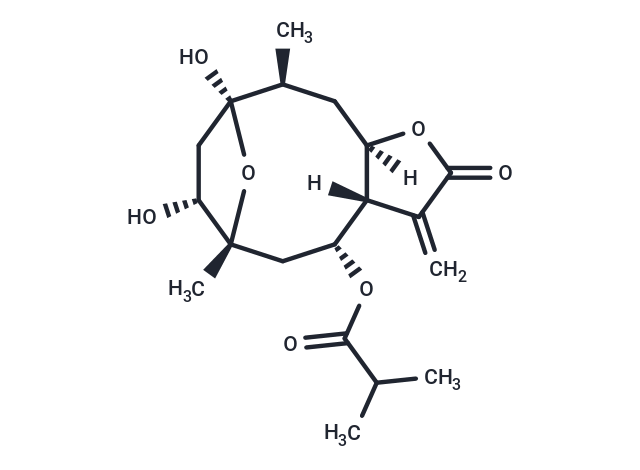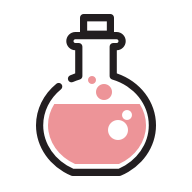- Remove All
 Your shopping cart is currently empty
Your shopping cart is currently empty
Shopping Cart
Tagitinin A
Catalog No. TN5091Cas No. 59979-61-2
Tagitinin A is a naturally occurring sesquiterpene lactone compound that acts as a dual agonist of peroxisome proliferator-activated receptor α/γ (PPARα/PPARγ) and exerts antihyperglycemic and antihyperlipidemic effects in diabetes research.Tagitinin A is able to bind directly to the ligand-binding domain of PPARγ (IC50=55 μM), and also stimulates the PPAR Tagitinin A can directly bind to the PPARγ ligand binding domain (IC50=55 μM) and also stimulate the PPARα-dependent activation of the SULT2A1 gene promoter. As a phytotoxin, Tagitinin A significantly inhibited the growth of wheat germ sheath.

Tagitinin A
Catalog No. TN5091Cas No. 59979-61-2
Tagitinin A is a naturally occurring sesquiterpene lactone compound that acts as a dual agonist of peroxisome proliferator-activated receptor α/γ (PPARα/PPARγ) and exerts antihyperglycemic and antihyperlipidemic effects in diabetes research.Tagitinin A is able to bind directly to the ligand-binding domain of PPARγ (IC50=55 μM), and also stimulates the PPAR Tagitinin A can directly bind to the PPARγ ligand binding domain (IC50=55 μM) and also stimulate the PPARα-dependent activation of the SULT2A1 gene promoter. As a phytotoxin, Tagitinin A significantly inhibited the growth of wheat germ sheath.
| Pack Size | Price | Availability | Quantity |
|---|---|---|---|
| 5 mg | $1,698 | Backorder | |
| 1 mL x 10 mM (in DMSO) | $1,869 | Backorder |
Bulk & Custom
Add to Cart
Questions
View MoreSelect Batch
Contact us for more batch information
Resource Download
Product Introduction
Bioactivity
Chemical Properties
| Description | Tagitinin A is a naturally occurring sesquiterpene lactone compound that acts as a dual agonist of peroxisome proliferator-activated receptor α/γ (PPARα/PPARγ) and exerts antihyperglycemic and antihyperlipidemic effects in diabetes research.Tagitinin A is able to bind directly to the ligand-binding domain of PPARγ (IC50=55 μM), and also stimulates the PPAR Tagitinin A can directly bind to the PPARγ ligand binding domain (IC50=55 μM) and also stimulate the PPARα-dependent activation of the SULT2A1 gene promoter. As a phytotoxin, Tagitinin A significantly inhibited the growth of wheat germ sheath. |
| In vitro | Plants with pesticidal properties have been investigated for decades as alternatives to synthetics, but most progress has been shown in the laboratory. Consequently, research on pesticidal plants is failing to address gaps in our knowledge that constrain their uptake. Some of these gaps are their evaluation of their efficacy under field conditions, their economic viability and impact on beneficial organisms. METHODS AND RESULTS: Extracts made from four abundant weed species found in northern Tanzania, Tithonia diversifolia, Tephrosia vogelii, Vernonia amygdalina and Lippia javanica offered effective control of key pest species on common bean plants (Phaseolus vulgaris) that was comparable to the pyrethroid synthetic, Karate. The plant pesticide treatments had significantly lower effects on natural enemies (lady beetles and spiders). Plant pesticide treatments were more cost effective to use than the synthetic pesticide where the marginal rate of return for the synthetic was no different from the untreated control, around 4USD/ha, compared to a rate of return of around 5.50USD/ha for plant pesticide treatments. Chemical analysis confirmed the presence of known insecticidal compounds in water extracts of T. vogelii (the rotenoid deguelin) and T. diversifolia (the sesquiterpene lactone Tagitinin A). Sesquiterpene lactones and the saponin vernonioside C were also identified in organic extracts of V. amygdalina but only the saponin was recorded in water extracts which are similar to those used in the field trial. CONCLUSIONS:Pesticidal plants were better able to facilitate ecosystem services whilst effectively managing pests. The labour costs of collecting and processing abundant plants near farm land were less than the cost of purchasing synthetic pesticides. |
| Molecular Weight | 368.42 |
| Formula | C19H28O7 |
| Cas No. | 59979-61-2 |
| Smiles | O(C(C(C)C)=O)[C@H]1[C@@]2([C@@](C[C@H](C)[C@@]3(O)O[C@](C)(C1)[C@H](O)C3)(OC(=O)C2=C)[H])[H] |
| Relative Density. | no data available |
Storage & Solubility Information
| Storage | Powder: -20°C for 3 years | In solvent: -80°C for 1 year | Shipping with blue ice. | |||||||||||||||||||||||||
| Solubility Information | DMSO: 16 mg/mL (43.43 mM), Sonication is recommended. | |||||||||||||||||||||||||
Solution Preparation Table | ||||||||||||||||||||||||||
DMSO
| ||||||||||||||||||||||||||
Calculator
In Vivo Formulation Calculator (Clear solution)
Please enter your animal experiment information in the following box and click Calculate to obtain the mother liquor preparation method and in vivo formula preparation method:
Mother liquor preparation method: 2 mg of drug dissolved in 50 μL DMSO (mother liquor concentration of 40 mg/mL), if you need to configure a concentration that exceeds the solubility of the product, please contact us first.
(mother liquor concentration of 40 mg/mL), if you need to configure a concentration that exceeds the solubility of the product, please contact us first.
Preparation method for in vivo formula: Take 50 μL DMSO main solution, add 300 μLPEG300
main solution, add 300 μLPEG300 mix well and clarify, then add 50 more μL Tween 80, mix well and clarify, then add 600 more μLddH2O
mix well and clarify, then add 50 more μL Tween 80, mix well and clarify, then add 600 more μLddH2O mix well and clarify
mix well and clarify
For Reference Only. Please develop an appropriate dissolution method based on your laboratory animals and route of administration.
Dose Conversion
You can also refer to dose conversion for different animals. More Dose Conversion
Tech Support
Please see Inhibitor Handling Instructions for more frequently ask questions. Topics include: how to prepare stock solutions, how to store products, and cautions on cell-based assays & animal experiments, etc
Keywords
Related Tags: buy Tagitinin A | purchase Tagitinin A | Tagitinin A cost | order Tagitinin A | Tagitinin A chemical structure | Tagitinin A in vitro | Tagitinin A formula | Tagitinin A molecular weight

Copyright © 2015-2025 TargetMol Chemicals Inc. All Rights Reserved.




